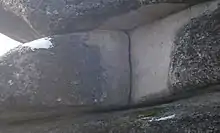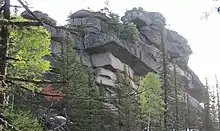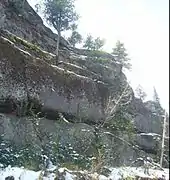Gornaya Shoria megaliths
The Gornaya Shoria megaliths, meaning Mount Shoria megaliths, are rock formations forming part of Mount Shoriya (Gornaya Shoria) (Russian: Горная Шория) in southern Siberia, Russia, lying to the east of the Altay Mountains.



Fringe articles have claimed these rock formations are gigantic prehistoric man-made blocks, or megaliths. It is reported that the largest pieces or blocks of stone have estimated weights between three and four thousand tons, which would make them larger than the megaliths at Baalbek, in Lebanon.[1]
Theories on formation
Russian popular articles have reported that scientists have proposed the rock formation to be the result of geological processes associated with the intense weathering of the rock composing Mount Shoriya.[2][3] Both tectonic forces acting on deeply buried bedrock and pressure release that occurs within nearsurface bedrock as it is uplifted and eroded commonly form rectangular, block-like, rock formations that consist of jointed rock.[4] Tectonic forces acting on deeply buried massive bedrock, such as granite, and pressure release as this bedrock is uncovered by erosion, can create sets of joints which are known as orthogonal joint sets, that intersect at nearly 90 degrees. Orthogonal joint sets quite often result in the formation of rock formations that are comparable in size and shape to the blocks shown in pictures of the alleged megaliths.[5][6]
It is quite common for spheroidal weathering, a form of chemical weathering, to occur as groundwater circulates through orthogonal joint sets in the near-surface.[7] This process results in the alteration and disintegration of bedrock adjacent to the joints. The preferential removal of weathered bedrock by erosion creates often creates bedrock blocks, which are called corestones. These bedrock blocks commonly have rounded corners and are separated from each other by cracks of variable size. Such corestones form both hills and mountains composed of exposed and rectangular blocks of jointed bedrock that are comparable to the rock formations found in the Mountain Shoriya. These hills and mountains are known as either tors or koppies.[8][9]
Notes
- John Jensen, Super Megaliths in Gornaya Shoria, Southern Siberia at academia.edu, accessed 19 April 2014
- Anonymous, На юге Кузбасса найден "сибирский Стоунхендж". at InfoSibnet dated 2013, accessed 22 August 2014
- Балаева, Е. Каменные «башни» Горной Шории at Smart News dated June 21, 2014, accessed 22 August 2014
- J. Ehlen, "Jointing" In S.A. Goudie, ed., Encyclopedia of Geomorphology volume 2 J–Z (New York: Routledge New York, 2014), pp. 578, 579-580 ISBN 9780415327381
- G. H. Davis, S. J. Reynolds, and C. Kluth Structural Geology of Rocks and Regions (John Wiley and Sons, Inc., New York, New York, 3rd edition, 2012, ISBN 978-0471152316), p. 864
- B. A. van der Pluijm and S. Marshak, Earth structure : an introduction to structural geology and tectonics (W. W. Norton & Company, Inc., New York, 2nd edition, 2004), 672 pp. 10110 ISBN 978-0393924671
- D. T. Nicholson, "Speroidal weathering." In S.A. Goudie, ed., Encyclopedia of Geomorphology, volume 2 J–Z (Routledge New York, New York, 2004, ISBN 9780415327381), p. 992,
- Piotr Migon, Granite Landscapes of the World (Oxford: Oxford University Press, 2006 ISBN 0-19-927368-5), p. 384
- Charles Rowland Twidale, and J. R. Vidal Romaní (2005) Landforms and Geology of Granite Terrains (London: Taylor & Francis Group plc, ISBN 0-415-36435-3), p. 351